Carol Sieburg asks me if I want to hold a baby, and before I can mumble "sure," she places in my arms a doll with a padded bottom and a weighted head that's so heavy it dangles backwards in a way that looks genuinely painful — even for a plastic doll. I can't just let the head dangle like that, I think instinctively, so I place my hand under the stiff, curly, synthetic hair and I hold the head up as if the doll were real.
People call Sieburg the Doll Lady. She's been a certified doll doctor since 1994, gluing and stringing and painting broken dolls in the basement of her home on the Northwest Side. Her Lincoln Avenue shop is wall to wall dolls — black dolls, white dolls, dolls called "Fairy Godmothers," with blue veins painted on arthritic hands and wrinkles carved around squinting eyes and puckered mouths. There are babies by Turner and Adora, and leggy, straight-kneed retro dolls like 1963's Charmin' Chatty, whose eyes peer to the side with mischief from behind a pair of eyeglasses.
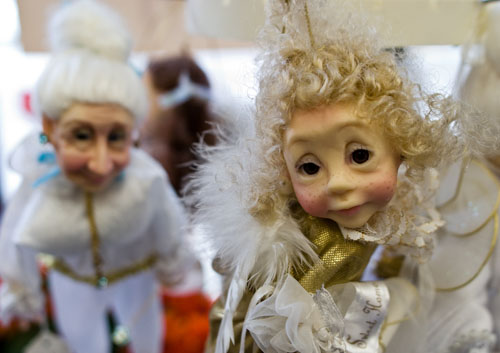
As I awkwardly cradle the baby Sieburg had handed me — a Lee Middleton and her favorite here — a large man in a do-rag pays for his purchase. I learn later that the man's name is Antonio Chapman, and he has shopped at the Doll Lady's Hospital and More for years, buying dolls for his aunts, nieces and grandmother.
"I have never seen a woman go from 67 to 7 so fast," he says to Sieburg, describing the way his grandmother changes when she interacts with her many dolls.
When his tall porcelain doll is boxed and bagged, the man asks Sieburg and her sole and longtime employee, Marie Leonard, for a big hug. Right away — he motions — before he gets all teary. The Doll Lady's Hospital and More will be gone April 19. Sieburg says she can't move enough merchandise to stay afloat, and even though she is close to Lincoln Square's pedestrian strip, foot traffic here, just south of Berteau, is low.
When Sieburg's shop closes, Chicago will lose one of its last independent doll retailers, leaving only Gigi's Dolls and Sherry's Teddy Bears on Northwest Highway and American Girl Place in the heart of the Magnificent Mile.
Before she was a doll doctor, Sieburg took her sister's Tiny Tears to Gigi's for repair. Her sister had hung onto the doll until its rubber body, battered by baths and baby bottles, had all but deteriorated and only a head remained. Gigi's fixed the doll, but today the shop sends most of its heavy-duty repairs to Sieburg.
Sieburg's home hospital will remain in business even after her Lincoln Avenue shop closes, and Sieburg says she has plenty of dolls to keep her busy. This September, Sieburg will also begin training a group of new doll doctors.
Sieburg does not speak highly of most mainstream dolls, least of all American Girl, a Wisconsin-grown company Mattel acquired in 1998. She's dismayed the fact that each doll's face, aside from differences in eye, hair and skin color, is cast from the same mold. "They're mass-produced drones, and they're now made in China," says Sieburg, who views the idea of a Chinese-made American Girl as oxymoronic.
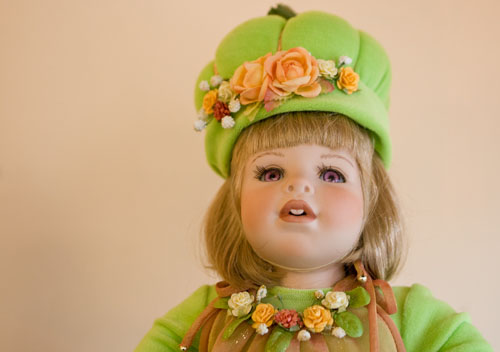
In spite of the lack of shops within the city limits, doll buyers can still find what they're looking for online. Sieburg isn't interested in moving her business there though. She says she can't compete with manufactures that sell directly to the public.
There are other reasons an online shop doesn't compare to what Sieburg has now. When she purchased the store from Jim Mowry in 2003, she did everything she could to give her shop a cozy "cottage feel," hanging lace curtains in the windows and painting the walls a soft pastel pink. She took the dolls Mowry had left her home, washing their dusty faces, laundering and ironing their tiny clothes.
If Chapman turns to the Internet the next time he buys dolls (he usually buys four times a year, Leonard says), he won't close his transaction with a hug, or chat with anyone about his grandmother, or reveal to people like me that doll-lovers are not just middle-aged women or little girls. The shop's closing is a loss for doll-lovers who found more than toys at Sieburg's store and an indication that the American doll market is changing.
"When you look at a doll and it makes you smile — that's your doll," Sieburg says, her gold-rimmed glasses gleaming between curtains of wavy gray hair. She is wearing a Lake Tahoe sweatshirt, comfortable jeans and sneakers, and moves easily about her small, cluttered shop, taking stock of her dolls. "When you're in love, that's it."
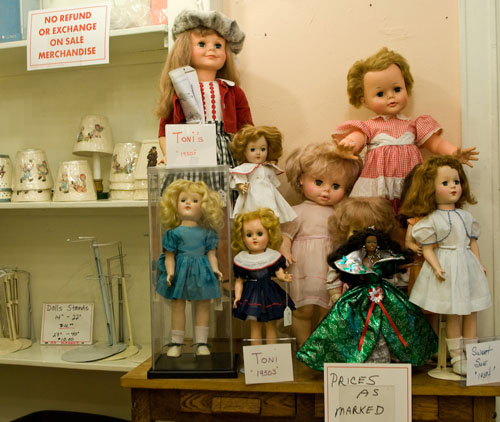
Sieburg sells dolls of every stripe, from hard, vinyl baby dolls to statuesque porcelain figurines — one of the latter appears to be pregnant under her long, apricot-colored frock, her red hair done up in the style of a Gibson girl. Some of these dolls come from Mowry's original collection, others come from Sieburg herself or were purchased at trade shows. The dolls range in price from $5 to $300. Sieburg often throws in a free stuffed animal for particularly well-behaved children, although the vast majority of her customers are grown-ups.
"I don't think women or girls ever grow out of a doll thing," Sieburg says. The last doll she received as a child was a boy she called Billy. Decades later, Sieburg was at Gigi's looking for a pair of arms to use for a doll she was repairing. As she paid at the counter, she noticed two doll heads on top of a cash register.
"I looked at that doll and I knew it was mine," Sieburg says. She recognized immediately that the lip paint on the doll head wasn't painted on exactly right — it was slightly off center, just as it had been on her Billy. The incident was one of many "serendipitous" moments Sieberg said led her to become a doll doctor.
The turning point in her career came just as Sieburg hovered on the verge of depression. She had been experiencing what she now recognizes as panic attacks, intense bursts of anxiety in which her heart would race wildly. To calm herself during one attack, Sieburg took a walk down Clark Street and wound up wandering into a Village Discount Outlet. A woman was rummaging through a bin of cheap merchandise and was comparing two dolls — one of which was quite attractive, the other needing serious repair. To Sieburg, it was obvious at first which doll the woman should grab. But then, something strange happened.
"The little Vogue doll just looked at me and said, 'help me,'" Sieburg recalls. She took home the battered doll, washed her, and took care of the tears in her body. She returned to the resale shop to buy the doll a dress and then again to buy more dolls, which she also fixed up and clothed. Not long after, Sieburg rented a booth at Andersonville's Summerfest to sell the dolls she calls her "rescues" and find them new homes. Pretty soon, people started coming to Sieburg asking her to fix their dolls. She took pleasure in making each doll "clean and beautiful and smiling and ready to go home to her own mommy."
Sieburg began to study the art and craft of doll repair, devouring books on the topic and attending a course in Pennsylvania. The Doll Doctor's Association was in its infancy, and Sieburg joined immediately to become a charter member and later president of the Illinois chapter.
For Sieburg, doll restoration is rewarding work, but even more fulfilling, she says, is handing the doll back to someone whose eyes are often welled up with tears. "That's a joy that I can give people," Sieburg says. "I don't know how else you could get that same kind of joy. I'm giving these people back their youth."
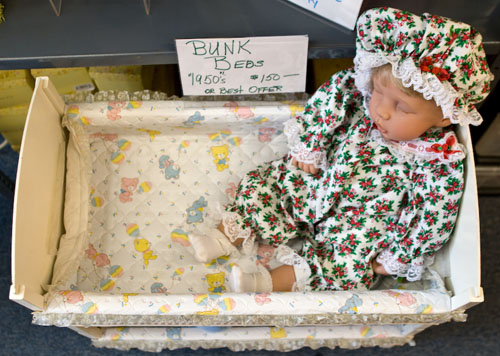
Leonard, 59, didn't always love dolls the way Sieburg does. "Dolls aren't something you need to have," she freely admits. But after four years in the shop, she now counts at least 25 in her collection — including a 20-inch Scarlett O'Hara and a porcelain doll that's almost as tall as she is. Leonard wears her straight dyed hair down and parted in the middle, a fringe of reddish blunt-cut bangs level above her eyes. While Sieburg has a passion for dolls, Leonard gives herself credit for shrewd retail skills she says have bolstered sales at the store, which has been busier than normal with the closing sale. She also has an obvious social knack, resonant in her throaty voice and deep laugh, that brings customers back — if not to buy dolls, at least for a chat.
Once the last of the dolls are packed up or sold, Leonard plans to join her 33-year-old son Simon in Dallas. She says she is ready to move on from dolls — and doesn't care if she ever sees another one again once she leaves. She'll continue to use dolls as a "decorating tool" indefinitely, but one day, she says, she may simply put them away in a box in her closet.
Leonard and Sieburg met at while working at Jewel. A friendship billowed over smoke breaks outside the store. Sieburg didn't know many co-workers outside the meat department, where she was stationed, but she joined a conversation with Leonard when she heard Leonard's mother was suffering from Alzheimer's, a disease Sieburg's father had also battled.
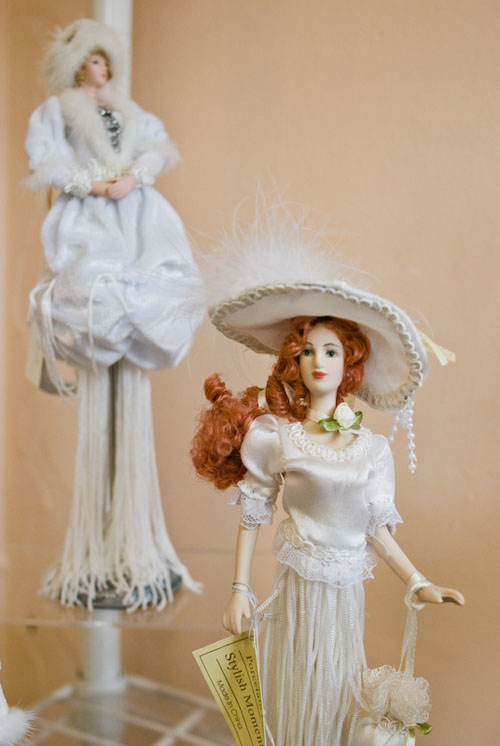
Leonard later told Sieburg about a dilapidated Toni doll she once treasured as a little girl. Her mother had got the doll for her in the 1950s by saving up box tops from Toni home permanents. When Leonard's mother died four years ago, Leonard asked Sieburg to fix the doll for her.
The two were seated in the shop with the Toni doll when Sieburg asked Leonard if it would bother her if she popped the doll's head off to take a look inside. Leonard told her to go ahead — but was nonetheless jolted by the quick snap of Sieburg's expert hand. Sieburg discovered she needed to take the doll home to repair the rolled-back eyeballs. Sieburg would return the doll to Leonard in near-perfect condition, dress mended, hair fixed and eyes bright.
"Isn't she cute?" Sieburg asks me, adjusting a doll with a bobbed haircut and large, hopeful eyes. Sieburg says she isn't satisfied with the long, white, vaguely baptismal gown she's dressed her in. Leonard agrees — "I don't like that," she snaps.
"She needs something," Sieburg says. When the doll was last dressed in velvety overalls and a blue and white checked shirt, some customers thought the little girl was a little boy.
The two women search for something feminine, settling on a pink and red Asian-inspired ensemble with a dragon emblem. They pair this with a straw hat, possibly made in China, but thoroughly Western in appearance. It doesn't quite work.
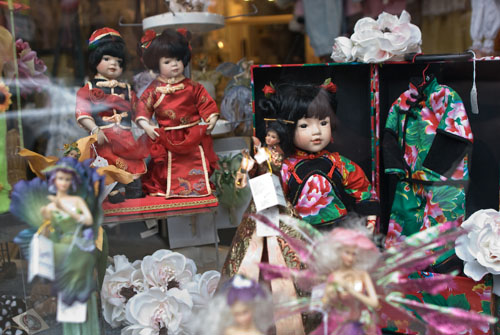
People think that dolls come ready made, Leonard explains, motioning to the perfectly posed figures that grace the shelves, waiting for a buyer. "There is so much work to get them ready," she says, focused intently on adjusting the doll's elastic waistband. "A lot of work for one doll," she says, not looking at me.
Few dolls on the market today receive the personal attention Leonard and Sieburg offer. At the back of Wicker Park's Kmart, beside a gallery of refrigerators, a glittering chaos of purple boxes draws the eye away from neat stacks of board games and Lego sets. It is here that I catch my first glimpse of Bratz, 2007's number-two brand among girls in the U.S. (Barbie placed a distant fourth). Only plastic separates my skepticism from their large, partially closed, almond-shaped eyes. Their look is slightly bored, almost stoned — similar to the one paparazzi often capture on Paris Hilton.
In a few moments, I have forgotten about the bonnets and bloomers Sieburg has to offer. The Bratz line, which rocked the toy market when it launched in 2001, has expanded into a dynasty of glitzy products, including Bratz Babyz Adventure Girlz, Bratz Itsy City, rhinestone-studded Forever Diamondz Fashions, and even a toy ATM to feed dollar bills. Piggy banks, and dolls as the Doll Lady may know them, are no more. I can't help but chuckle at Bratz' handheld math tutor, Math in the Mall, which uses shopping scenarios to frame story problems. "Math has never been so stylin'," the box screams.
Further down the aisle, the color shifts to Mattel's unmistakable pink. But the Barbies — which include Country Girl, Soccer Coach, Mariposa and Baby Doctor models — can't quite compare to the glam of Bratz. The 49-year-old Barbie line also contends with the Yummi-Land ice-cream pop girls, which come in a giant soda bottle, the plush iPals, which have speakers in their paws, and the Hi-Glam dolls, whose bendy legs are as tall as an average Ken. Nearby, dolls rooted in powerful pop-culture brands — miniature versions of Hannah Montana, Hillary Duff and the cast of High School Musical — vie for attention. Even American Girl, which once specialized in dolls from various periods of American history, seems to have taken note of stiff competition. Today, historical dolls like Addy, a former slave, and Kirsten, a Swedish immigrant, receive little space in the catalog, which is dedicated to dolls that more closely resemble the modern girls who play with them.
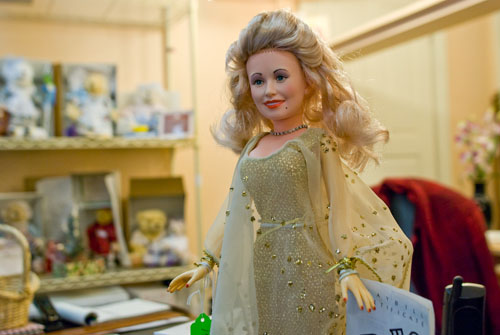
To get an edge in this contentious market, many doll makers, including Bratz and Barbie, have followed Webkinz' lead, creating an online world that doll-buyers can enter via a code that comes with their doll (or stuffed "kinz"). The popularity of these online crossovers has proved the importance of the Internet not just for retailers, but for products themselves. In big-box stores such as Kmart, there are noticeably few baby dolls.
Sieburg suspects that the Bratz dolls and their "kinky, flashy, purple clothes" are popular mostly because they're fashionable and current. In the Doll Lady's words, the girls who play with Bratz and even American Girls aren't "little mommies." Dolls may still be popular, but their purpose today is not to teach little girls how to be mothers (or boys how to be fathers).
Sieburg recognizes that pretending to be a mother is not and should not be the only pastime for girls. As a child, she played baseball, dressed in a cowboy clothes, and played with Tinker Toys and Erector Sets as well as dolls. Nevertheless, she believes that learning "how to be a mommy, how to hold a baby, and how to cuddle," is important for little girls. Learning to be tender and loving, she says, is equally important for little boys.
"I know it's probably old fashioned," Sieburg says, "but that's just the way I feel."
Most of Sieburg's customers are adults like Louise Rodes, a young-looking grandmother with straight, sandy-blonde hair. She'll often come to the shop with her 7-year-old granddaughter — it's easy for them to spend hours in this tiny space — but today Rodes is here alone, pawing through plastic drawers of pint-sized fancy pants and knitted booties. She's hoping to find something for one of her Thumbelina dolls. She received her first Thumbelina as a little girl in the early '60s — twisting a plastic dial at the back of the doll would cause Thumbelina to wriggle slowly in a lifelike manner. Rodes used to work near the doll shop, and it was over a barbeque lunch at Smokin' Woody's across the street that she and her co-workers first spotted it. After spending a lunch hour digging through doll clothes and chatting with the amiable Leonard, Rodes was hooked. The way Rodes can troll these bins — some of which are dedicated exclusively to "ice and roller skates" or "red shoes" — the drawers seem bottomless.
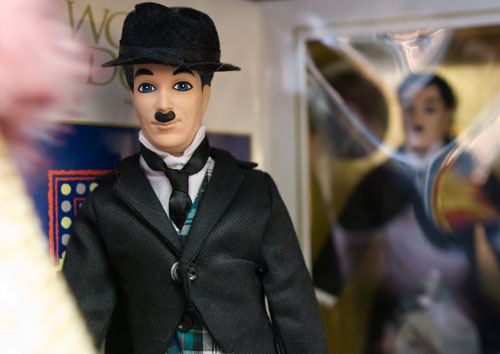
The dolls here at the shop — from the heavy, pouting babies to the airy, porcelain figurines — are too perfect to accurately imitate life. Perhaps for some grownups, this flawlessness is a source of comfort in unpredictable lives. Dolls have played many roles in history — sacred objects, guardians in the afterlife, images to which ill will or disease could be transferred. In ancient Greece, young women offered their dolls and other trappings of virginity to the god Artemis before marriage. In the American Southwest, elders pass down hand-carved Kachina dolls, representations of powerful spirits, to Hopi children. In some sense, these dolls keep a culture alive. As Sieburg puts it, "Dolls have been around as long as people have, and I think they will continue to be around."
Sociologists have recognized that dolls are a means to enact adult social roles, for better or worse, and a window into the human self — in a famous study on racial self-identification in the 1940s, black children showed a preference for white dolls, reflecting the racism engrained in U.S. society.
Yet here at the Doll Lady's Doll Hospital and More, the doll's most evident role is simply an object to be cared for and loved.
The shop crowds as a family of three enters. The mother and her married daughter are regulars, I learn, and they survey the shelves with discerning eyes, giving a small nod to dolls marked down 30, 40 and 50 percent. The gray-haired father, in tapered-leg jeans and a black leather jacket still stiff with cold from the outside, trails behind the women as they move toward Caramina, a winged porcelain doll holding a butterfly wand. Caramina, usually $150, is on sale for half price. A few fingers are chipped off, but that doesn't matter to the women, who know plenty about adhesives.
Sieburg says that to be a doll doctor, a person has to be "a painter, sculptor, mechanic and engineer." Her workshop is filled with power tools, paints and epoxies that would make Bob Vila jealous.
"People used to call me a cannibal," Sieburg says. As a doctor, she often must take parts from one doll and use them to restore another doll.
Dolls are traditionally held together with strings or bands inside the body. The bands are pulled taut, connecting around hooks within each limb. Sieburg shows me how these hooks have become shorter and less substantial since most doll production has moved abroad.
"You can keep him if you need a good body or legs," she says to Leonard, handing her a small Madame Alexander doll in a sailor suit, who is missing his arms.
Sieburg says she will never take apart a doll in front of a child because of the terror it can cause. When she had to repair a stuffed animal for a little boy, replacing its worn outer fur, she sewed the animal's original coat inside with its stuffing. The smell, Sieburg says, told the boy the repaired animal was the same one he had loved so much before. His mother couldn't thank the Doll Lady enough.
There's nothing Sieburg loves more, she says, than to see a child and dragging around a stuffed animal or doll that's falling the part at the seams from being played with so much. People will even get stuffed animals repaired so they can take them along to college, she says.
Sieburg says she often adjusts charges based on a customer's income level. For an elderly woman living on a fixed income, Sieburg repaired a poorly strung doll for free. "That's part of the joy too," Sieburg says.
Leonard, who mans the shop while Sieburg is working at her home hospital, has seen customers of all sorts. She remembers when a drunken man staggered in the doll store at 10:30 one morning.
"Are you sober enough that you can look around here?" Leonard asked him, worried he'd knock over some of the dolls. "Go home, sober up, and come back," she told him. Soon after, he returned to purchase a collectable Native American doll.
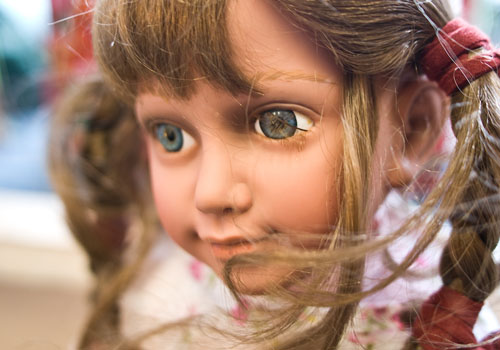
The doll with the blonde bob is still causing problems for Sieburg and Leonard. The red pants and pink dragon top don't seem to suit the doll's sweet and shy personality. After rifling through homemade vintage dresses, many done in bold, still-fashionable dots and stripes, Sieburg emerges from the back of the shop with a clear plastic bag containing a pair of rose-colored floral pants and a white top. She and Leonard eagerly open the package and dress the doll. They take turns combing her hair down, tying her hair back, and tying it on the side. When their busy hands are finally at rest, the doll's face looks brighter — more lifelike — giving the impression that the doll herself is somehow more content. After some deliberation, Sieburg and Leonard agree upon pink patent leather Mary Janes and lace-trimmed bobby socks. The finishing touch is a tiny stuffed bear for the doll — in need of her own miniature — to hold. (A plush lamb was vetoed at the last minute.)
When the job is done, Leonard asks Sieburg if she's ready for a cigarette. Sieburg dons a puffy, white Baby Phat coat and steps outside to take a puff on an extra long filter. Even though she owns the shop, she always smokes on the sidewalk. And if she ever has to curse, she does that outdoors too. "Never in front of the dolls," she says.
The Doll Lady's Doll Hospital and More, 4161 N Lincoln Avenue, Chicago.





